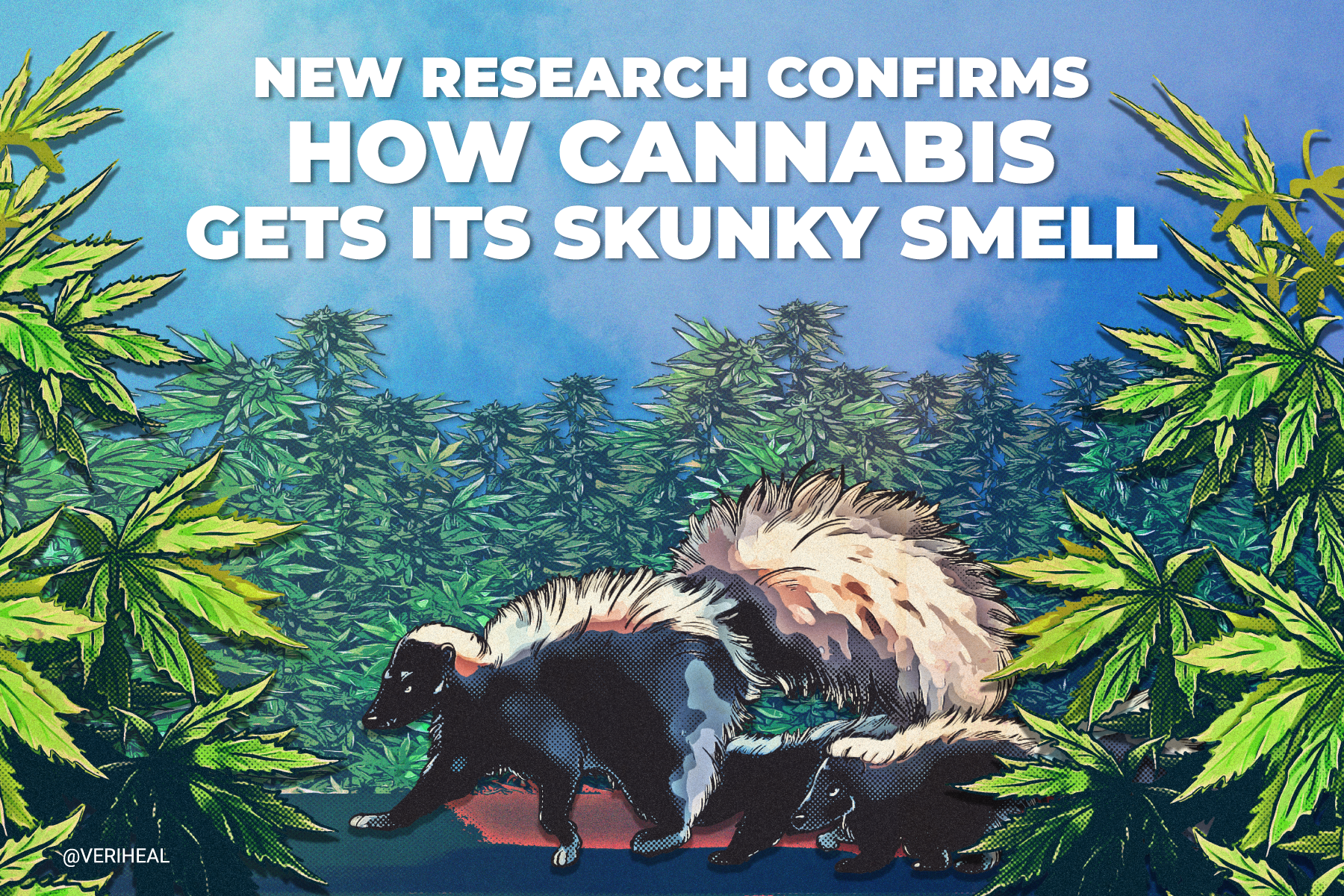Each cannabis strain has its own aroma, some being more distinctive than others. All, however, share a “skunky” scent that has become widely associated with cannabis by users and non-users alike. But where exactly does this smell come from—and are skunkier-smelling strains better?
A study published in November 2021 in the peer-reviewed journal ACS Omega holds many of the answers. While many have speculated that the skunk smell could be attributed to the terpenes, or aromatic compounds, of cannabis, the research team behind the study actually discovered a whole new class of volatile sulfur compounds (VSCs) to thank for the cannabis-skunk phenomenon.
Studying the Chemical Makeup of Cannabis
A team from the department of research and development at Abstrax Tech, a cannabis research and technology firm, set out to make sense of the skunky smell associated with cannabis by conducting a study of the aromatic properties of the plant. To do so, the team leveraged state-of-the-art equipment to closely analyze the chemical makeup of cannabis plants.
The researchers made use of 2-dimensional gas chromatography (2DGC), mass spectrometry, flame ionization detection, and sulfur chemiluminescence on the cannabis flower samples. Through these tests and analysis, the team discovered that the VSCs essentially contained organic compounds that housed sulfur called 3-methyl-2-butene-1-thiol, or 321MBT.
These compounds are what we call volatile sulfur compounds (VSCs) and were found to be the reason behind the skunky aroma. The researchers explain that these VSCs have also been linked to the aroma and favors in the Allium plant genus, such as chives, onions, cabbage, Brussels sprouts, etc.
Uncovering New Cannabis Compounds
While the VSCs have been found in the Allium plant genus, those found in cannabis are most similar to the chemical composition of those found in Allium sativum, more commonly known as garlic. It was also suggested that this chemical composition of the VSCs may explain the many health benefits associated with garlic.
Plenty of studies have linked terpenes to the distinctive aromas of various cannabis strains, but the Abstrax team explains, “Nonetheless, there is little evidence that they provide the characteristic skunk-like aroma of cannabis.” This makes sense when you consider that each terpene boasts a specific aromatic profile, and none of these profiles come close to a skunky scent.
According to Professor Robert J. McGorrin of Oregon State University, VSCs “play an important role in the aromas of bread, popcorn, nuts, potato products, and wine, and contribute subtle flavor characteristics to cheddar cheese, chocolate, and tropical fruit flavors…” Since the VSCs are responsible for the skunky aroma of some cannabis strains, it should be no surprise that the compound is also found in skunk spray.
Why You Should Get Your Medical Marijuana Card
Veriheal has satisfied millions of patients nationwide by giving them access to these benefits
- Larger purchase limits
- Peace of mind
- Enhanced legal protection
- Access to higher potency strains
- Save up to 25% on cannabis purchases
- Skip the line at the dispensary
Daily Mail explains that Kevin Koby, Abstrax chief scientific officer, believes this discovery will help to “preserve the volatile sulfur compounds as new cultivars emerge, regardless of the rigors of processing, packaging, and time on the shelf,” adding that it will also “help brands maximize their products and literally push cannabis quality to the next level.”
The study’s findings confirm previous ones. In 2021, research by Professor Jacek Koziel also found that the skunky aroma was caused by 321MBT. This means that the research from Abstrax further confirms that this compound is responsible for the skunky-smelling cannabis. However, the previous research did not identify the compound as a VSC and simply stated that it contained sulfur.
The Scoop on Skunky Cannabis
Skunky-smelling cannabis may sound undesirable, but is actually quite sought after by frequent cannabis consumers. Why? The skunk strains are legendary for being used to breed countless other strains. However, misinformation spread by media sources has created an association between skunky cannabis and street weed. One source even went so far as to call skunky cannabis a dangerous street drug that causes mental illness. Fortunately, we know better now.
In fact, there are several skunk descendant strains that are considered to be landrace varieties, some of which have even won awards at the cannabis cup. Skunky cannabis strains are some of the most recognizable due to their distinctive smell. Previous hypotheses aiming to identify the compound causing the smell suggested that it was the myrcene terpene; however, that aroma is more spicy than skunky.
Skunk cannabis strains have been bred since somewhere in the 1970s and traces of them can be found in the majority of strains available these days. Skunk varieties are also said to be quite potent as well as being able to grow in pretty much any condition with quick flowering periods. These days, you are more likely to purchase skunky strains that are the result of crossbreeding so that farmers may yield more in shorter periods of time.
Popular Skunk Strains:
- Skunk #1 (the mothering strain)
- Super Skunk
- Pineapple Skunk
- Island Sweet Skunk
- Sour Diesel
Despite the fact that there is a lot of confusion concerning the safety of skunky smells, we have researchers to thank for continuing to demystify the available information. Skunky cannabis strains are not more dangerous than other cannabis strains. The only thing that makes them different from other strains is the compound they contain that causes the smell, which we now know to be the volatile sulfur compounds.
Thanks to these studies, consumers no longer need to wonder what causes the skunk smell or whether the media’s accusations of its dangers have any validity. The skunky aroma of cannabis strains is now without a doubt the result of sulfuric acid…but if the scent is not for you, then you can choose to consume some of the more fruity and sweet-smelling cannabis strains.
Author, Share & Comments
















